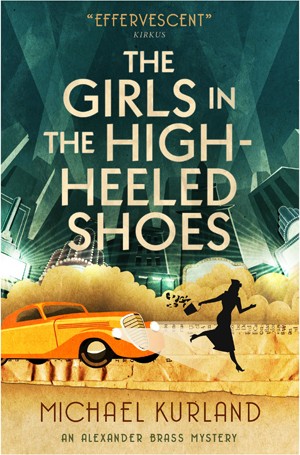
This author is perhaps best known for his series of comic historical thrillers featuring that infamous criminal mastermind Professor Moriarty. You can read our review of the most recent book in that series, Who Thinks Evil, here. Recently, Titan Books republished another of his historical thrillers, Too Soon Dead, and now Kurland’s 1998 follow-up novel has been reprinted as well.
The Girls in the High-Heeled Shoes continues Kurland’s Alexander Brass series and is set in Depression-era New York. Brass is a celebrated columnist for the New York World who counts such legendary wits as Damon Runyon and Dorothy Parker as his literary peers. His beat is Broadway, its theatres and its nightlife, and his daily column reporting on the activities of the celebrated actors, glamorous chorus girls, and rich theatrical producers is eagerly devoured by his thousands of fans looking for something to take their minds off their daily struggles. Nightly, Brass, alongside his assistants Morgan DeWitt and Gloria Adams, do the rounds of the fashionable cafes and nightclubs, picking up tips about the comings and goings of celebrities from their legion of informants, all keen to see their stories appear in Brass Tacks. Nothing notable escapes his attention, and of course that includes the news which isn’t fit to print.
The novel is narrated by DeWitt who has a touchingly star-struck relationship with his boss. DeWitt has literary ambitions of his own, but somehow his great American novel never seems to get past the first couple of chapters before being abandoned for a better idea. DeWitt’s self-deprecating recording of his difficulties in writing fiction is surely a way for Kurland to relate his own experience of the creative process, and is one of the pleasures of this charming book.
On one of their nightly rounds, Brass and DeWitt are cornered, so to speak, by Cholly-on-the-Corner, a longstanding theatrical hanger-on, who is concerned that Two-Headed Mary is missing. The Runyon-esque nicknames for some of Broadway’s more colourful characters are another delight. To the marks leaving the theatres, Mary is a charitable campaigner looking to help poor orphans, but to those in the know she is a successful con-woman conversant with all the short and long grafts. Her nickname, and no-one knows her real name, arises from the spurious charity she collects for, which purports to help the ‘two-headed orphans that are victims of claustrophobia’.
Initially, Brass is not too concerned, as people like Mary are itinerant by nature, often disappearing for short periods before returning as someone else with a different con game. But Mary continues to be absent, and soon others, including producer K Jeffrey Welton, begin asking Brass for help. It seems Mary really is missing, and the more Brass and his gang investigate, the more the mystery deepens. It seems Mary has a famous actress daughter; that she has more money than expected; that she had links to one of New York’s most famous grifters; and that she knew Billie Trask, a theatrical cashier who disappeared along with the takings from a hit musical, Lucky Lady.
When Billie turns up dead in Central Park, and Mary’s daughter receives a frantic phone call from her, delivered in criminal code, that she is being held hostage somewhere within the city, Brass and his friends need to solve the mystery before Mary’s life is ended.
By now Kurland is a dab hand at historical settings. The same skills he used to bring Victorian England to life are used to illuminate 1930s New York. You will feel right there in the hustle and bustle of Broadway, alive with the potential that another star could be born any minute. Yet it’s strangely sad too; a place where dreams are broken daily. Kurland is a dab hand with dialogue, and introduces a lot of theatrical slang giving colour and humour to the story.
The mystery is rather perfunctory, and there is probably too little of it in this book for true crime fiction lovers. However, a good deal of pleasure is to be had spending time with the amiable narrator, DeWitt, and there’s a real sense of camaraderie among the principal characters.
You can read more about Michael Kurland’s books in our feature on the best Sherlockian pastiches here.
Titan Books
Print/Kindle/iBook
£4.99
CFL Rating: 3 Stars






